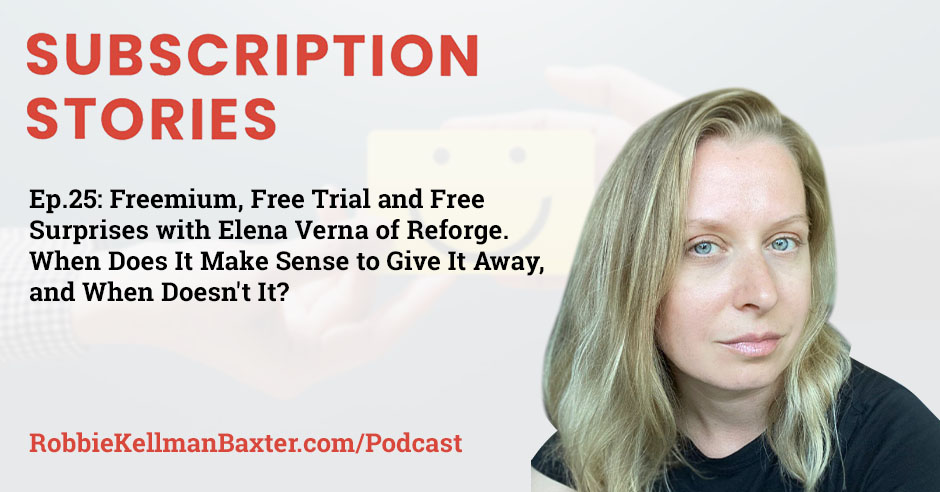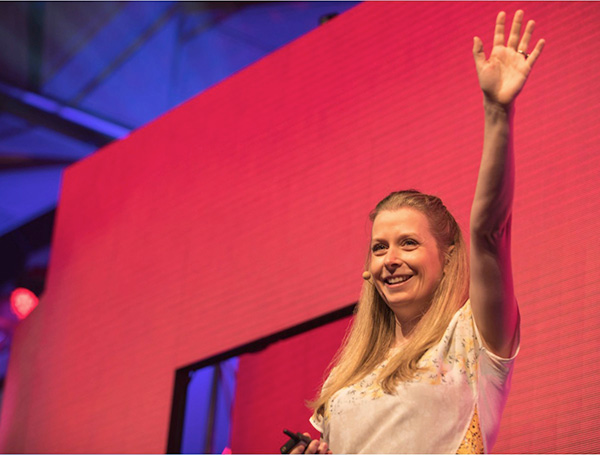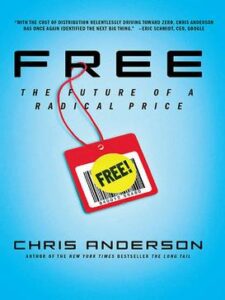
“Every business will always have a room for free at some point in their strategy.” Elena Verna, Reforge EIR and Partner, joins Robbie to talk about the merits of giving away freemium offers in a subscription business. She also talks about strengthening customer relationships, the process of genuine business growth, and the importance of having a growth leader.
Some businesses today give products and services for free to entice customers to purchase more. However, a huge number of entrepreneurs distance themselves from giving away a freemium offering because of the risks of decreased revenue. But for Elena Verna, Reforge EIR and Partner, this must not be the mindset. Sharing her work in Survey Monkey and Malwarebytes, she explains to Robbie how every business strategy can benefit from freemium offers and impact customer relationships. Elena also dives deep into the real process involved in achieving genuine growth in a business, and why every team must invest in having their own growth leader.
—
Listen to the podcast here:
Freemium, Free Trial and Free Surprises with Elena Verna of Reforge. When Does It Make Sense to Give It Away, and When Doesn’t It?
In my work with subscription and membership models, one of the books that influenced me the most was Free: The Future of a Radical Price. Free was written by Chris Anderson, Editor-in-Chief of WIRED Magazine and published in 2009 by Hyperion. That book got me thinking about the role of Free in subscriptions in a more strategic and systemic way. If your business hasn’t analyzed the possible role of free in your business model, whether it’s a free trial, a free sample, or a freemium offering, you’re missing out. The judicious use of Free can be one of the most powerful tools in your subscription pricing toolkit. Our guest, Elena Verna, is a growth enthusiast and pricing expert. She’s been responsible for growth at companies like Miro, SurveyMonkey and Malwarebytes. Now, she’s at Reforge, a membership-based learning community where she teaches monetization. In this conversation, we’re talking about the role of Free, the rise of growth as a discipline and what it means to truly be data-driven.
—
Welcome to the show, Elena.
Thank you for having me, Robbie. I’m glad to be here.
You’re an entrepreneur in residence at Reforge and a teacher. Reforge is a learning community with a tagline, “Where Tech Comes to Scale.” What are you teaching in your monetization class?
What I teach on monetization is everything that I’ve learned, not only from talking to other incredible leaders at those companies, but also experienced myself through my work at SurveyMonkey, Malwarebytes, Miro, or a slew of advising companies that I’ve been engaged with. How do you come off from not having a success moment, an intuition, a theory that you’re going to go and fix or improve your monetization model, but how you apply a scalable framework where you can make data-driven decisions? You can apply scientific method in order to find the best possible monetization model for your company.
This comes from patterns, many instances of what success and failure looks like, and putting it into place where it’s applicable to any industry and any business because fundamentals, skeleton of it, is fairly similar, it’s just there’s different evidence that augments some of the decision-making that you have to do. It’s exciting to bring people away from looking at monetization as the price and pull them out into monetization as an ecosystem that drives your acquisition, that drives your retention, that defines your growth model for the business. The more you tie it together where the value that you can get out of the monetization is closely aligned to the value that you’re getting to customer, the better your business is going to be in the long-term.
Just because you had that one success does not mean that success is scalable. Share on XYou brought up a bunch of important points that I want to emphasize. One of them is that a lot of what you’re teaching comes from the trenches. It comes from working with a variety of companies, not just one, not just academically, but trying to come up with the right pricing strategy, the right retention strategy, the right acquisition strategy to optimize revenue in a lot of different companies and building out frameworks. That combination of being in the trenches, taking all that data, and trying to come up with frameworks that can be used by different organizations is tricky. A lot of entrepreneurs think that because they’ve had one success, they’re all good.
It’s tricky from multiple perspective. Just because you had that one success does not mean that success is scalable. You might’ve had luck. It’s incredible if you had luck, but it’s important to understand why that success occurred. We spend a lot of time doing it. We take it for granted and then we want to replicate it in the next business or the next company that we go and work on. That’s not always the case. You need to understand why it’s happening. Most importantly, we look at the revenue growth as a success metric, an outcome, and an actual input into our decision-making versus revenue comes at the end of creating an incredible experience for your customers.
If you don’t put revenue in perspective and if you rely on few data points of successes that you’ve had, you have a big probability of failure going forward because you haven’t created patterns around it and you’re still fundamentally acting on intuition. What intuition unfortunately creates is a huge perception versus reality gap for your customers because you don’t fully understand through quantitative, qualitative, or experimentation datasets of where the opportunity is and you’re following your intuition, which is guided by your historical experiences, which can be flawed, especially if the inputs in the previous company were completely different and into that decision-making framework.
I had, as a guest last season, Hunter Madeley, who is the CEO of Vena. He had, like you, been at multiple successful companies and talked a lot about the risk of bringing the playbook from the prior company and handing it out to the new team and saying, “This is how we’re going to do things.” How do you teach people to manage their intuitions which did get them pretty far with data? How do you balance that? If you’re completely data-driven and you don’t go with any hunches or any intuition, you run the risk of never making any leaps forward.
Stalling your innovation.
How do you balance that? What do you teach at your class? What’s your point of view on intuition versus data?

Freemium Offering: Understanding where your monetization model is working or not becomes the crucial deciding factor for continuously evolving and growing the company.
Both are important. However, to me, it’s important to understand why my intuition worked. There’s always inputs into my intuition. Some of them are quantitative. Some of them are qualitative. It’s great to have a fantastic intuition, but people that have great intuition are usually understand the decision-making pattern that happens in their brain, maybe some subconscious level, but there are still inputs that go into your intuition. If you have a gut feeling but it’s unsubstantiated by anything, that’s great but that’s not replicate-able, not scalable and not sustainable. To me, it’s always reverse engineering. Some of the decisions that one company were making to understand what are the inputs that led into it, what were the right assumptions, what were the wrong assumptions to create that sustainable, scalable growth, because then you need to be able to drive those “intuitions” at the sustainable predictable level going forward.
Your intuition goes into your hypothesis, “I have a feeling this is going to work.” You do a test and then you look at the results and say, “Did my hypothesis prove out?” It’s intuition data. When you talk about being data-driven, you have this #DataDriven that you put at the end of a lot of your emails, notes and your biography. Is that what you mean by being data-driven?
For me personally, it goes even further than that. It’s important to make decisions forward based on what happened in the past. If we don’t learn from our history, if we don’t learn from the data that we have, how can we do best predictions of what’s going to work in the future? Otherwise, we’re not learning from what happened in the past. That’s why being data-driven is so near and dear to my heart. I want to evolve myself, the company and the industry. For that, we need to learn from the past what worked, what didn’t and then move forward and take appropriate risks when they’re justified. If we don’t look at what happened in data, which data is always historical, there’s little data that can predict things for you accurately, but if you’re not looking at historical data, then you are missing a big part of validation for some of the decisions that you need to make. It blows my mind when people disregarded or they say, “No, I want to go and follow my intuition.” This is an input. I’m not saying you have to make a decision on this input, but I’m saying that it has to be an input in your decision-making, and then you can add any other assumptions that you want to make on top of it. Without it, you’re shooting in the dark. Why shoot in the dark if there is already light that you can turn on so you can know which direction to go?
Can you give me an example of a time that you combined your intuition with data to make a good decision?
I’ll give an example of Netlify, which is the company that I’m working in advising. We have been collecting a lot of data of how our monetization model at Netlify is working with our developer user base. There are some places that it works wonderfully. There are some places that is clear. There is a lack of product-market fit in our monetization model to certain use cases. It’s important to understand what works and what doesn’t in order for us to take the next step of evolution in monetizing our platform at Netlify. To me, I have a clear existing revenue where it’s working, how it’s happening that I need to protect and continue growing, and the huge opportunities that we still have whether the monetization decelerate some of the growth or we failed to monetize certain sectors that I can go and evolve monetization model to.
If we don't learn from our history, we cannot fully prepare for the future. Share on XYou mean that you have a product, it’s selling well in some markets, and there are other markets that you thought it was going to do well in that and it’s not doing well in?
Correct. By looking at the usage of the product, we are identifying that certain segments are not being monetized in the way that we top-down believe that they should be monetized in terms of what our overall strategy is against. You have areas and segments and markets that it’s working in wonderfully, and then certain areas that we think you should be working in, but it’s not. Understanding why it’s not working and then evolving the monetization model to both encompass to existing segments that it’s working for because we don’t want to alienate anybody, but then also evolve it to the point where it works for all of the segments that we want to monetize within our user base is important. Otherwise, I can change it to whatever I feel my intuition, the most simplistic version that I want, but then I have a high risk of losing existing revenue and not even capturing new opportunity in revenue. The full understanding of where your monetization model is working or not becomes the crucial decision factor in terms of how to continuously evolve and grow the company.
What I like about that example is that you broke down between, “We thought it was going to work here, and here. It’s working here but not in the other places. We’re going to set the successful thing aside and understand why we were successful there so that we don’t damage it, and then we’re going to focus on understanding where we went wrong with our assumption about the other market, and then we’re going to adjust.” What you’re doing is you’re doing it in a narrow and precise way, almost like a surgeon, “We’re going to protect this area and this area and focus on this area.” You’re using the data, you’re looking back, and saying, “What did we think was going to happen and where did something different happen?” Please tell me if you agree or don’t agree, but whether you have tons and tons of data to support this, or even the process of analyzing and looking at what happened in a more precise way. It’s going to help you move forward without throwing the baby out with the bath water.
Two things, it breaks down the huge monumental problem into pieces that are more tactical and more manageable to address and to answer so it doesn’t become like, “I need to boil the ocean.” There’s a focus that I have. Number two, it’s not about the quantity of the data. A lot of times, even if you don’t have any quantitative data to support it, you can go and talk to customers. You can start seeing patterns in the interviews. A lot of it can be solved with qualitative approach so it’s not all about quantitative. When I say data, data can take so many different lenses. To me, it starts in quantitative. It’s augmented with qualitative and then it finishes with experimentation dataset that connects quantitative and qualitative together. In quantitative, I know what is happening. Qualitative is telling you why it’s happening and then they can understand how I can connect what and why through AB tests and experiments, where if I change something, I can see impact on the behavior for the customers. You don’t have to have it all. Even small insights from your customer sometimes can make a huge difference in your ability to make the right decision for your strategy and your company.
It’s important to not throw up your hands and say, “We’re a small company so we don’t have data.” You can always ask your customers. You can always look at what you thought you were going to sell and what you haven’t sold. There’s always some data. I appreciate that you point out that you don’t need a data analytics team and lots of fancy platforms. You could do it in a more bootstrapped way.
It’s about being a data-driven culture. It’s whenever all of the people that are working at your company are looking for the data in order to augment their decision-making. It has nothing to do with whether or not you have an analytics team. As you scale, in order for that data to be proactively surface to the decision-makers, you do need to have an analytics team, but I never advocate for a huge analytics team at the beginning, even at the company of a size of 100 people, you think you need to have maybe two analysts, max, that to start with for you to be able to surface some of those insights. It’s a necessary function of a culture. It’s not a subject of whether or not you have an analytics team.
You don’t need an analytics team. You need the culture of analysis of looking at data to make your decisions. You’ve been thinking a lot about the role of free and freemium. Can you define what that is first?
What freemium means to me is a big strategy for the company as a whole because freemium is such a loaded concept in terms of the goodness that it can deliver to your company. It can displace your competition sneakily because you offer it for free versus charging. It can drive your product-led growth framework for your business because your free users can generate either network effects or virality within your product. It can be an incredible product-building asset, especially with the network effects or user feedback that you can generate. It can attract opportunistic audiences that you’re not solving for, but because your product is free, they’re already becoming an adjacent customer that you can evolve your strategy to.
It can be an important vector of how you lower your cost of acquisition for your enterprise businesses so it can change the dynamics of profitability for your company. Yet, a lot of people are seeing free as, “I have a paid plan or I have a paid product. Should or should I not give something away for free?” That, to me, is trying to almost optimize your paid as opposed to saying freemium is the core of my strategy that has a multi-pronged approach in terms of benefits that it’s delivering to both my customers and my business. It’s driving so much more than just my monetization. It’s a strategic move. I believe that if you don’t take now or when the time is right, I’m not saying for every industry the time is right, that somebody will and they will disrupt you by taking that move.
Freemium is a free ongoing offering alongside a paid ongoing offering. You talked about free trial and free as an ongoing thing versus as a one-time thing. You talked about all of the different uses that free can play in your business model. Did you ever read that book by Chris Anderson, Free?
No, but I need to. It’s on my reading list on my next vacation.
It blew my mind because he took the concept of free and talked about every way that it’s been used in the history of business and about the emotions and the psychology of free and why people are willing to try something for free but not for $0.1, why we take free stuff at trade shows, some little squeezy toy even though we’re like, “What are we going to do with this when I get at home?” He talks about how to thoughtfully incorporate it into your business model. You made a pretty impassioned speech about the power of free and how you’re a zealot on this topic. Have you ever had an experience with a company, you’ve worked with a lot of companies where you came to the conclusion that there was not a role for free in their business model?
Never shoot in the dark if there is a light that you can turn on and guide you in the right direction. Share on XI have never come across the business where I don’t believe there’s not a role for free at some point in their strategy. It’s all about timing. I’m not saying that everybody should go freemium. In some cases, your cost dynamics will not allow you to make a profitability out of that strategy, but all of our costs are continuously going down. We’re becoming more and more efficient and effective. At some point, the dynamics in the equation start to make sense. Is it for everyone now? No, but I have never come across the business that I would not be able to envision some free version. Some point in the future if they want to either launch or if they want to displace a competitor going up or down the market.
You and I have both worked with SurveyMonkey. I worked with them early on my journey to understanding subscription models. They were the second client. I have Netflix first and SurveyMonkey second. Those were two formative experiences in terms of thinking about what makes subscription models work, and more specifically, the role of free. As you know, Netflix has a two-week free trial, which in some places is doing away with. SurveyMonkey has both free trials and they also have a freemium model where you can use a version of their product for free forever and get tremendous value without ever paying them a cent. I featured SurveyMonkey in my first book in the Chapter on Pricing. I’m curious when I worked with them, they were going from one paid offering to three. Now, they have multiple personal options, business options and free options. I’m curious what you make of their pricing journey. What does your pricing philosophy say about some of the choices that they’ve made?
SurveyMonkey, when they started, their main competition was paper surveys. What does it take for you to create paper surveys? Nothing, you maybe download a template, you write something up in Docs, and you print it. It’s the cost of paper and printing. They had to go and change fundamental habits of how people are surveying markets which is a pretty big ask. All of a sudden, instead of handing out these papers, I have to ask you to go into this link and submit your answers. There are so many more efficiency and effectiveness gains. It’s so much better for the planet. It’s a much more scalable way of collecting feedback, but it’s a fundamental change of habit that already exists. When you’re going up against changing existing user habits, you need to think hard about every single friction that you will introduce along that journey. Pricing, where you have to pay for something, is one of the biggest frictions in customer psychology and customer’s mind. They will give it a try if it’s free and if there’s no friction, especially more of a pioneer persona within us, they will go and they will attempt it, but the moment the paywall comes up and especially if I have not seen that this way is better than my old way, then forget it. They will never would get an adoption and they would never enter the market and scale to the point that they’ve scaled now.
SurveyMonkey was extremely smart from the beginning even though they were bootstrapped going with freemium offering to market because they understood that they need to change fundamental user habits. They needed to lower that friction and monetize on more complex use cases from segments that were a lot more price-insensitive that wouldn’t mind paying for it, but they still saw the value through freemium offering. They have two types of personas. One is the type of people that will never pay, and that’s okay. They drive so much more virality and casual contact through distributing surveys to respondents and our respondents are aware of SurveyMonkey brand. There is a second segment where people get the value, they get to the a-ha moments within the product and then they go pay. It’s a lot more monetized on usage compared to being monetized right at the beginning before I have an understanding of my probability to materialize the value that the product can deliver.
There are a couple of important things that I want to tease out. One of them is, in the case of SurveyMonkey, they started with free. They had the freemium offering first, and then as they identified segments that could benefit from additional features and services, they created higher-level tiers. Looking at professional market researchers, for example, who said, “I’ll pay a premium to be able to store my data.” Enterprises that said, “We’ll pay a premium to have all of our surveys with our own design on it.” These new features that they’re getting on top of that. You’ve talked about the starting point being, get it out there for free so people get used to doing their surveys digitally, so it’s free and then that leads to paid.
The opposite is also true that many organizations find that they have a product. You talked about Google. There are a lot of personal productivity apps out there, a lot of subscription-based or ongoing-based productivity apps that find themselves competing with Google Docs and saying, “They’re giving it away for free.” For them, it’s almost a loss leader because of the way that Google uses free in their business model versus the way that I use free in my business model and suddenly, I have to match my competition. That’s where you go from paid to free. I agree with you that in both cases, it’s forcing innovation and the customer does benefit, but it’s interesting to think about how it can go both ways. You can go from free to paid. You can also be forced to go from paid to free.

Freemium Offering: Because your product is free, they’re already becoming an adjacent customer that can evolve your strategy.
It’s unfair advantage of what Google can offer for free. There’s no question about it. They don’t care about profitability of their certain business lines because it’s capturing the market, but I love what it does to the rest of the text company segments to force to think of how they can innovate on top of what Google is giving for free.
It’s like a 4-minute mile.
We, as consumers, benefit from it. Is it unfair? Absolutely. Does it create better products out there? Yes. Do I wish Google did it this aggressively? Maybe not, but fundamentally, we are better off as an industry because some of those dynamics are happening. It pushes us to the limits of innovation and it continuously drives us to create a much better offering for our customers, so they choose you over Google.
It’s interesting to have these competitors that do these outrageous things like offering their products for free. It does force more creativity and more discipline among the rest of us. One of the things that I’ve noticed is you and I are both here in Silicon Valley where a lot of companies are venture backed. That gives them a big runway before they have to make money. They can say, “This is the vision.” Monetization is not just about your price, it’s about the strategy to get to revenue and saying, “We’re going to give some things away for free today because tomorrow we’re going to own the market, or we’re giving things away for free to build adoption, to create habits, and we’ll generate revenue tomorrow.” The rest of the world doesn’t work like that. Most of the rest of the world is quarterly capitalism, “We have to hit our number this quarter. We can’t afford to invest for the long-term.” A lot of the readers work with big, traditional, successful companies that are far away from Silicon Valley. How would you advise them to think about this role of a free, especially in terms of building ongoing relationships with their customers?
A couple of comments on what you said. Does venture capital enable potentially more companies to go free? Yes and no. It enables sloppy freemium implementation as opposed to making it thoughtful and strategic because they have all of these extra funds to play with and they don’t care to make their cost bases offer-able right from the beginning. Is it only venture capital companies can go freemium? No. Are the venture capital companies do freemium? They’re doing sloppier because incentives are not necessarily there. There’s a lot of companies that did freemium that are bootstrapped from the beginning. SurveyMonkey is one perfect example. Malwarebytes, a cybersecurity company that I’ve worked in the past, also did freemium right from the beginning. Miro online whiteboard platform also did freemium right from the beginning.
That forces you though to understand the unique advantage of your freemium that can deliver to your business model so you can play on it right away. Whether you have the funds like Google or venture capital to enable it, that’s the kicker. That’s amazing. That’s great that you have that ability to do so, but that does not limit you to whether or not you should be doing freemium. They have to think about it from a lot more strategic way and evaluate your equation of cost analysis for freemium from a different lens.
Every business will always have a room for free at some point in their strategy. Share on XTwo things that I’m taking away from that is, number one, just because you have venture money does not mean you’re going to be strategic in how you spend it. Number two, it doesn’t give an excuse if you’re bootstrapped or if you’re a public company and you have different constraints. It doesn’t give you a path from innovation and from considering the power of free. The other thing that you talk about is that you have to think about what the return on the investment is. That’s the concept of monetization is. It’s not just about I give you something and you give me some money back. It’s I’m thinking 2 or 3 steps ahead about what is going to create value that somebody is willing to pay for in the future as well. It’s understanding how all the pieces fit together. We’ve talked about monetization. I know your title in many of the organizations where you’ve had a leadership role has been growth which is a verb or a noun several years ago. Now, it’s a job. What does it mean to be in growth? If I ask you what you do, you don’t say, “I’m in sales, I’m in marketing or I’m in product.” You say growth. What does that mean? Especially for people who haven’t heard that job title before.
Growth, for me, is an intersection of acquisition, retention, and monetization strategies. That’s what results in growth. What does it mean on the actual company level? On the company level, it’s taking data and it is tying product, marketing and sales activities together to result in the best outcome possible. Growth is not about creating innovation and the next horizon for your product or developing your products. Growth is not about improving the scale or infrastructure. Growth is about taking what you already have and using products, marketing, sales at the intersection of acquisition, retention, and monetization increasing distribution of what you have to the max. It’s taking your existing product and landing it into as many people’s hands as possible. What does that mean? That means to understand all of the user journeys, the drop-offs, where you’re servicing the right segment, where you’re not. It’s breaking down the silos between the departments and creating value for the customer to make sure that you have the right acquisition strategy to get them in the best way possible that you are retaining them appropriately. You’re monetizing them in the best possible way that the value exchange between you and the customer is at the optimal stage.
If there are limited spots at the executive table, what loses out? There are many new titles, chief blank officer. If you have a Chief Growth Officer who is above product, marketing, sales, does that mean that those three people lose their spot at the table or does the table get bigger?
I don’t think it should be above. To me, it’s a partnership but I prefer growth teams that are not reporting into marketing or not reporting into product because I don’t want to be incentivized about what products is trying to achieve. I don’t want to be incentivized by what marketing is trying to achieve. I want to be incentivized on the company level and tie the two together so there is good friction that is happening between the departments and I can be the glue between them and sit side-by-side with them. In a table, do you still have somebody responsible for engineering and a CTO, Chief Technical Officer? Yes. Do you still need Chief Product Officer? Yes. Do you still need Chief Marketing Officer? Yes. Do you still need operations? Yes. Sales and growth are also important aspects that you need to understand how important it is to your strategy first of all.
Not all the time that growth team is something that you need to have. It’s also dangerous to create growth team too early in your company because everybody should be on the growth team up until a certain scale. It’s only after you go into specializations of the teams, which starts creates silos and potentially disjointed experiences for your customer, and you enter after product market fit into that scale stage as you’re moving towards your second horizon on your product innovation, that’s where growth team can help you. I won’t put growth hire as my first hire. I would also not put the growth team if the company were not ready to focus on self-serve monetization or is not ready to focus on there’s nothing too broken about the user journey. There has to be a real pain point that you’re solving.
There’s a right place at the right time, depending on what your growth model is. Growth can sit closer to marketing and product. It’s one of those roles that I’m most confused about myself because it means so many different things across different companies. Head of marketing is a pretty standardized definition across company-to-company. Head of growth can mean a slew of things from one company to next. It’s one of the most encompassing titles because it fundamentally says, “This is how this company grows.” How the company grows AKA its growth model is authentic and local decision on each company even in the same space, even in the same industry, because that’s their competitive advantage most of the time.

Freemium Offering: You’re responsible for your customers’ performance in your product, and not for any specific functionality within it.
The two takeaways I have from what you said for me, personally. One of them is that you don’t need a growth person at the beginning. You need a growth person when you reach a certain level and you’re trying to get to the next level. I’m curious what that level is so hold that thought. The second thing that is interesting is that one of the signals that you need a growth leader is when the user journey feels broken, which we’ve all experienced. I’ve seen it with a lot of my clients where sales say, “We’re doing a great job. We’re selling a lot.” The customer success team, the support team or the account team says, “They’re not staying.”
Retention.
What I love about what you said is it’s the person who’s responsible for all three metrics.
It’s a department responsible for driving metrics as opposed to delivering on marketing campaigns or delivering on certain features or one metric. They can be metric of focus. You’re responsible for the performance of your customers in your product not for any specific functionality within your product.
You said, early on, everybody’s doing growth, everybody’s working together, probably they’re all sitting in the same at the same desk in the same room. At what point would you advise a company, as a rule of thumb, to start thinking about whether they need a growth lead?
A couple of questions that I would want to ask, “What are they trying to solve with the growth lead or the growth department?” A lot of times, there has to be a well-articulated problem statement. “We’re losing customers because of this or we have suboptimal experience here. We have nobody responsible for this,” but there has to be already an ongoing indication that there’s an opportunity to be had. There something that already exists in the product that is not getting to the max distribution of possibly of how far he can get, but you also need to understand why. It’s most dangerous to hire somebody, especially with senior title and say, “Go figure out what growth means for me.” Growth is your heart in your company. It’s what’s pumping all of the blood through all of your system.
Growth is like the heart that pumps blood throughout your business system. Share on XIf you tell somebody else like, “Go figure out where my heart is located in the body. I don’t even want to know.” You can outsource that out. You have to do a lot of that, work yourself, understand what your growth system is and where the biggest opportunities and then hire people to pressure test those assumptions. For that, you need some scale. If you’re just trying to get to product-market fit so you’re not even operating or even that ensured that you’ve truly solved the market problem, you don’t need a growth team. You need to get to the product-market fit, get to feature parity, get to an a-ha moment for the customers and see some of those retention numbers that you’ve solving somebody’s problem. As you start to grow, as you start to scale, what’s going to happen with your acquisition is going to start lowering an intent. Your customers that you’ve achieved product-market fit are no longer the customers that are coming through to your product.
That’s where most of this perception versus reality, discrepancy, and customer experience starts to happening because you don’t understand and you’re not surfacing everybody’s problem. I wouldn’t hire a growth team, for example, to fix retention. To me, retention is a much bigger issue right out the front. If you don’t have it, that potentially has issues with your product-market fit, you’re not marketing to the right use cases, or you’re not getting the right use cases to monetize. I wouldn’t hire somebody to go fix it. I would try to understand what my opportunities are and then hire the right growth person with the right skill set to be able to help you address the right area in your business or growth.
Work for the CEO to do before they hire the growth person so that they know where to send that growth person once they’re brought in.
CEO, CPO CMO, anybody on that side, whoever’s holding that torch can come up with original growth model hypothesis. I’m against of outsourcing that because then you in the company have the most evidence to come up with the best hypothesis of what drives growth for you. Don’t outsource it to outsource to somebody else that is likely going to slop some templates on you and then it potentially will lead you nowhere.
Do you want to do a speed round? I want to ask you a bunch of quick questions for you to respond to off the top of your head.
Let’s do it.

Freemium Offering: Even small insights from your customer can make a huge difference in your ability to make the right decision for your company.
What’s the first subscription you’ve ever had?
What’s your favorite subscription of the COVID era?
What’s something valuable that you got for free?
Mentorship. It’s not product-related, but mentorship from incredible people in my life.
What’s a time you felt like a member, someplace where you truly feel like you belong?
SurveyMonkey, for me, is where I felt that I was part of the ecosystem. It’s one of the most memorable and defining moments in my career. I truly felt like I was a vital part of that company.
This was such a good conversation. Thank you so much, Elena Verna, for being my guest.
Thanks, Robbie, for having me. It’s such a great conversation
—
That was Elena Verna, entrepreneur in residence and partner at Reforge. For more about Elena and about Reforge, go to Reforge.com. Thanks for your support and thanks for reading.
Important Links:
- Elena Verna, EIR and Partner, Reforge
- Buy Free: The Future of a Radical Price on Amazon
- WIRED
- Reforge
- Subscription Stories Episode with Hunter Madeley
- Vena
- Netlify
- Spotify
- Blue Apron
- Miro
- SurveyMonkey
- Malwarebytes
- Netflix
About Elena Verna
 Elena is a Growth enthusiast, advising a number of companies such as MongoDB, Netlify, Maze, Livestorm, and Outsystems. In the past was accountable for growth at Miro, SurveyMonkey, and Malwarebytes. She is also Reforge EIR and Partner, a membership-based learning community, where she is busy creating & teaching courses to growth practitioners.
Elena is a Growth enthusiast, advising a number of companies such as MongoDB, Netlify, Maze, Livestorm, and Outsystems. In the past was accountable for growth at Miro, SurveyMonkey, and Malwarebytes. She is also Reforge EIR and Partner, a membership-based learning community, where she is busy creating & teaching courses to growth practitioners.
Elena’s superpowers sit at the intersection of product, marketing, and data within B2B self serve + enterprise companies, specializing in freemium+subscription monetization motions. Data is her love language (#bedatadriven!) and she values nothing more than a good business framework discussion.
Love the show? Subscribe, rate, review, and share!



